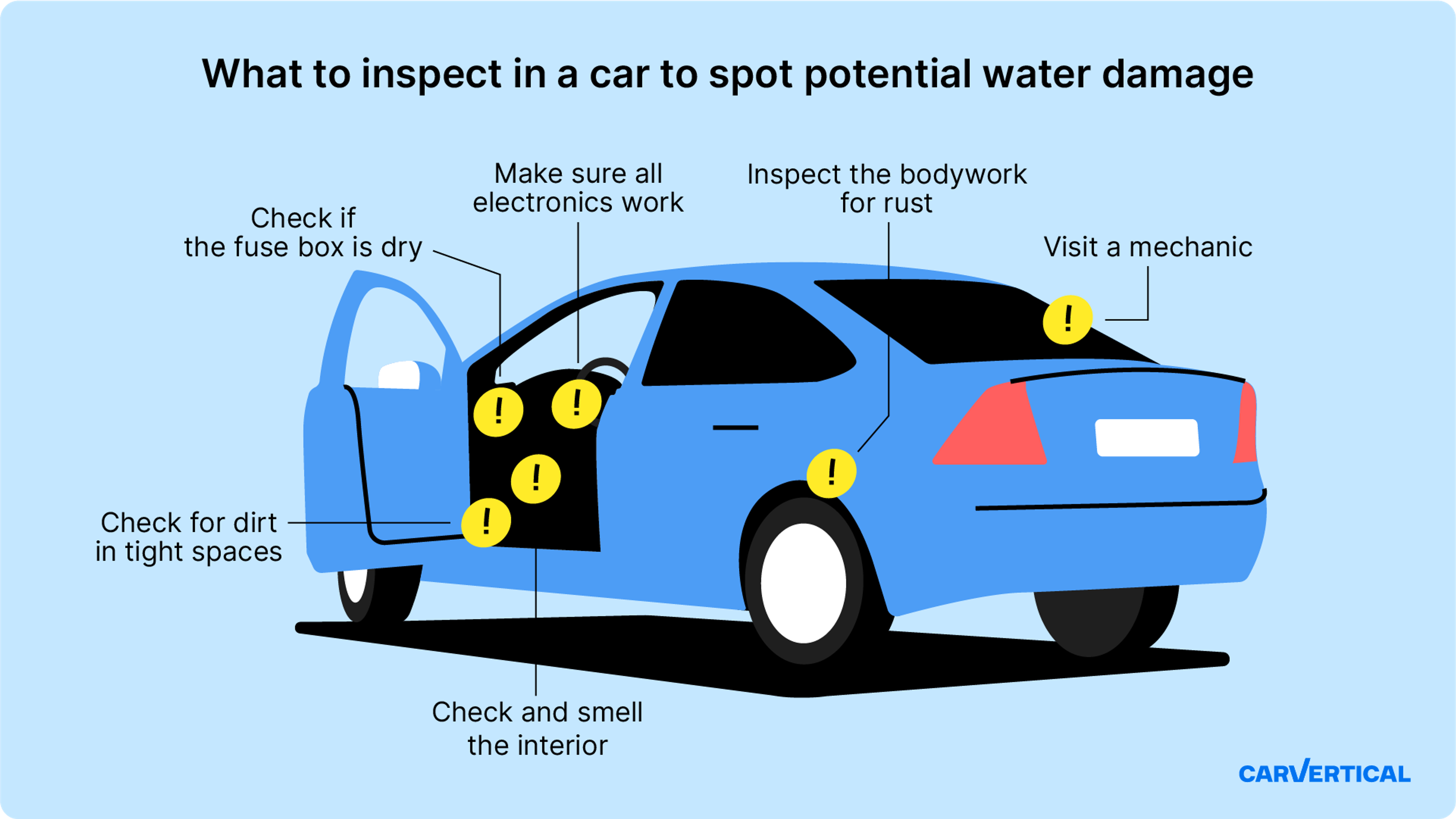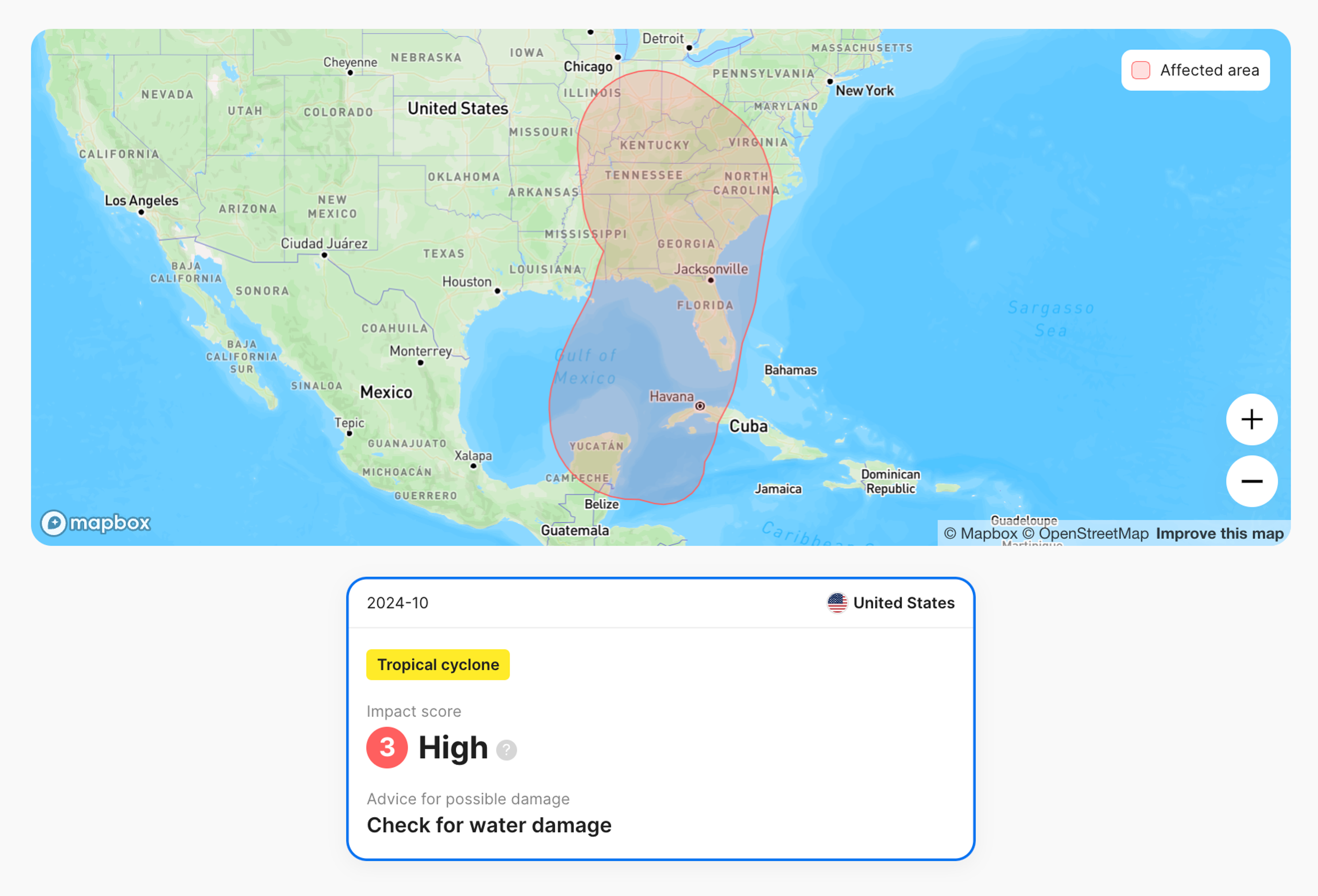Table of Contents
How to detect signs of flood damage in cars
Many cars that have been submerged in water end up in the hands of buyers who have no idea about their past. While some signs of flood damage are obvious, others can be subtle or cleverly disguised by dishonest sellers, leading to long-term problems.
Fortunately, there are ways you can spot signs of flood damage, including thorough visual inspection and checking the car’s history on carVertical. Here’s how to do it.

Used cars have dark secrets
Reveal them all! Just enter a VIN code and click the button:
How can you tell if a car has flood damage?
Knowing how to spot a flood-damaged car is crucial, whether you’re just browsing or about to buy. Many used car sellers try to hide these essential details, but there are some telltale signs that a car has been underwater.
Here are some key checks to help you spot a flood-damaged vehicle:
- Test electronics. Faulty electrical systems are often the first sign of water damage. Make sure to test the entertainment system, power windows and mirrors, door locks, and lights to make sure they all work.
- Open the fuse box. Nearly all electrical systems are connected to the fuse box, typically found under the dashboard, in the boot, or in the engine compartment. The fuse box should be dry, and the fuse connections should be clean and free of corrosion.
- Inspect the bodywork. Car bodies are prone to rust from excessive moisture, especially if the car has been exposed to salt water. Carefully inspect the bodywork, paying extra attention to the undercarriage, door trims, badges, and plastic components. Even small bubbles in the paint can signal the presence of rust hidden beneath the paint.
- Check the interior. Ensure the interior is completely dry, especially footwells, seats, and other fabric areas. Soft materials tend to remain wet for a long time, so feel them, particularly in the lower areas of the car. Your hand should come away dry after touching these areas.
- Smell the interior. Get inside the car, shut all doors, and take a moment to smell the interior. Damp seats and carpeting often leave behind an unpleasant, mouldy odour that’s difficult to mask, even with air fresheners.
- Look for dirt in tight spaces. As floodwater recedes, crannies and crevices in a vehicle often trap dirt and debris that’s hard to reach, especially inside the car. Check for dirt between interior plastic parts and under the seats. Dirty (but not dusty) areas may be a sign that the vehicle has been flooded.
- Take it for a professional inspection. It’s always a good idea to have an independent mechanic inspect the car. Not only can they spot potential mechanical issues, but they may also detect additional signs of flood damage.

Some severely flood-damaged cars can be sold for up to 50% less. Used car salesmen buy them for next to nothing, resell them for a relatively low price, and still make a hefty profit. Always remember that a suspiciously low price usually has a reason behind it.
Get a carVertical report to learn about possible exposure to floods and other damage
You can learn whether a vehicle could have been located in a flooded area by getting a carVertical vehicle history report. This can make you more aware of such a possibility and prompt you to inspect specific car areas. Moreover, our reports can highlight records from other natural disasters, such as tropical cyclones.
Pay attention to the impact score, which indicates how severe the event was based on data from the Global Disaster Alert and Coordination System (GDACS).

You can also use information in other sections of the carVertical report to learn about water damage. For example, look at historical photos and check for fogged-up headlights, a suspiciously clean engine compartment, or water level signs inside the car.
Another option is to check for water-related title brands (e.g., Flood) in the “Title Check” section (for cars that are in or imported from the US).
All you need is a vehicle’s VIN number that you can typically find stamped on the bottom of the windshield, driver’s side door pillar, front end of the frame, or vehicle’s documents.

Check your VIN
Avoid costly problems by checking a vehicle's history. Get a report instantly!
Water can cause serious damage to cars
Water is a great conductor and a key component for the formation of rust, which spells trouble when it gets into the wrong parts of a car. When submerged, water can seep into every crevice, causing short circuits in electrical systems. Although electrical connectors and control units are typically sealed, they aren’t waterproof, allowing water to penetrate the most sensitive areas of the vehicle.
Drying out a flooded car takes days, and even then, there may be irreversible damage, such as oxidised wires, mouldy seats, or a sagging headliner. Water trapped in tight spaces can remain inaccessible for months, leading to electrical problems, recurring mould, and unpleasant odours.
Ideally, a flooded car should be completely dismantled, with all electrical wires disconnected and the interior taken apart, only to be put back together once everything fully dries out. Unfortunately, used car sellers often don’t invest that much time and effort, choosing to sell damaged cars instead.
Is a flood-damaged car repairable?
Note that there’s always a huge risk to buy a flood-damaged car – even if it seems all the damage is fixed, there’s always the possibility that certain parts will deteriorate and break down over time.
Whether a flood-damaged car can be repaired – and whether it’s practical or cost-effective – depends on the severity of the damage and the specific systems affected.
| Water level | Potential damage |
|---|---|
| Up to the tire bottom | The damage may be limited to carpeting, upholstery, and some electrical components, which are not complicated to repair. |
| Tire mid-point | Possible damage to brakes, wheel bearings, and electrical systems if water intrusion occurs. |
| Tire top (wheel rim) | Risk of water entering the exhaust or sensitive undercarriage components. Braking efficiency might decrease. |
| Halfway up the doors | Water could seep into the cabin, damaging carpets, electrical systems (e.g., power seats, sensors), and causing corrosion. |
| Windows | Severe damage to interior, electrical, and mechanical systems. Engine hydrolock likely if not shut off in time. |
| Fully submerged | Total loss in most cases. Damage to all systems, including engine, transmission, electricals, and structural components. |
If the flooding was minor, such as water rising only to the floorboards, the damage may be limited to carpeting, upholstery, and some electrical components, which are not that complicated to clean or repair.
Water reaching the dashboard or higher is a bigger issue already. It can significantly affect electrical systems, engine components, and the transmission. These types of damage require more extensive repairs and could be very costly.
If the car was completely submerged, the water may have damaged critical systems such as the engine, transmission, and electronic control units (ECUs), which might require a complete overhaul or replacement. In addition to the fact that the cost of these repairs may sometimes exceed the vehicle's value, it’s also important to consider the vehicle’s long-term reliability when deciding whether to repair it.
Note that there’s always a huge risk to buy a flood-damaged car – even if it seems all the damage is fixed, there’s always the possibility that certain parts will deteriorate and break down over time.
Is it worth buying a flooded car?
In most cases, no. While you might take a risk on a flooded antique or rare car for restoration purposes, choosing a flooded car as your daily driver is likely a bad idea. Although the lower price may seem tempting, you could end up spending more than expected to ensure the car is safe and reliable.
However, if you come across a flooded car and still want to buy it, negotiate the price as much as possible to ensure you’re getting a decent deal.
FAQ
How can you tell if a car has flood damage?
Look for these signs:
- A musty odor
- Water stains or mud in the interior (especially under the carpet or seats)
- Rust on screws or metal parts
- Corrosion on electrical components
- Moisture trapped in headlights or taillights
Which car parts are the most vulnerable to flood damage?
While everything from the engine to the body panels can be affected, electrical systems are the most vulnerable to water damage. Connections can become corroded and short circuits can cause system failures.
What damage does a flood do to a car?
Flooding can damage a car's engine, transmission, and electrical systems. It causes corrosion, contaminates fluids, and can ruin the interior, including the upholstery and electronics. Water can also lead to mold and rust throughout the vehicle, making it costly to repair and overall not safe.
At what level of water is a car considered flooded and ruined?
Serious damage occurs if water reaches the dashboard, as it can harm critical electronics, engine components, and safety systems, making repairs very expensive or impractical.
Can flood damage be repaired properly?
Flood damage can be repaired, but it might not be cost-effective. If wiring looms, control units, or the engine have been submerged, the repair cost could exceed the car’s value.
Are flood vehicles worth buying?
Flood vehicles are generally not worth buying due to potential long-term issues, such as rust, electrical problems, and engine damage. Even if repaired, they may have hidden damages that affect safety, reliability, and resale value.